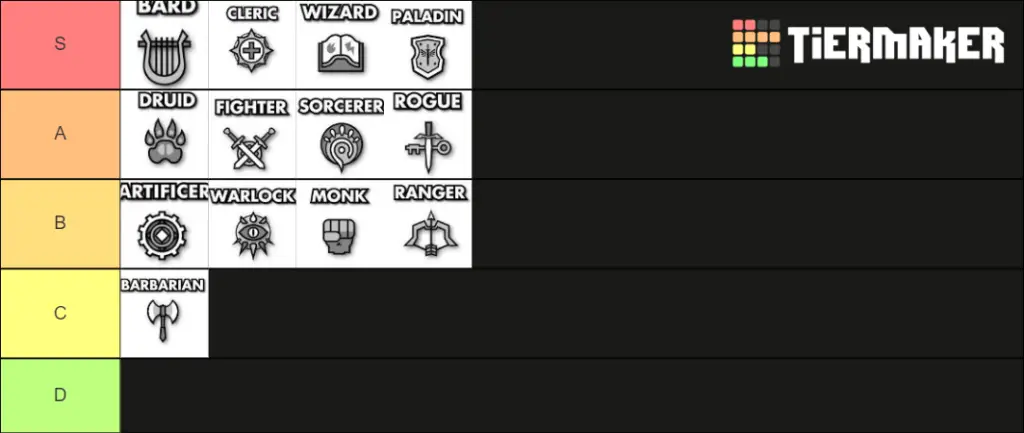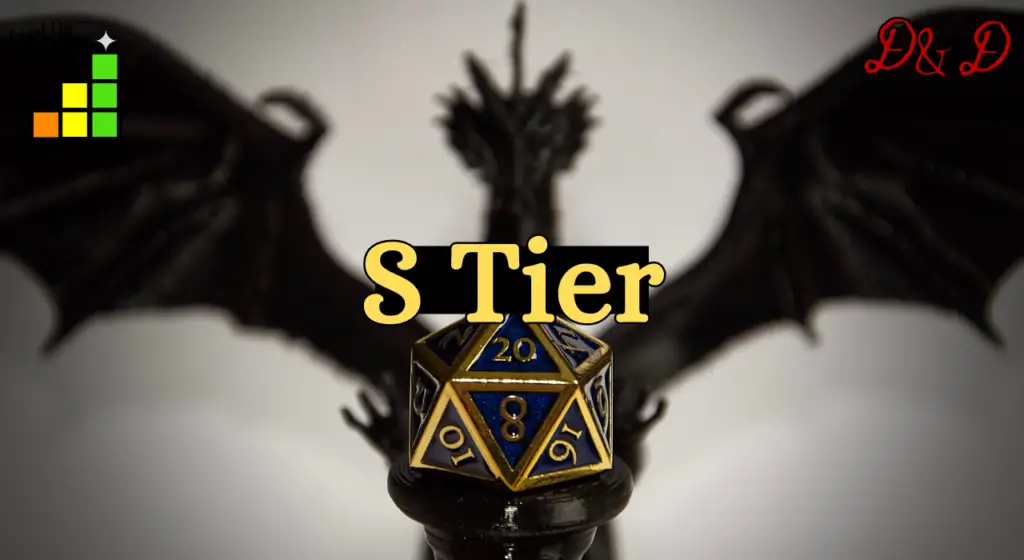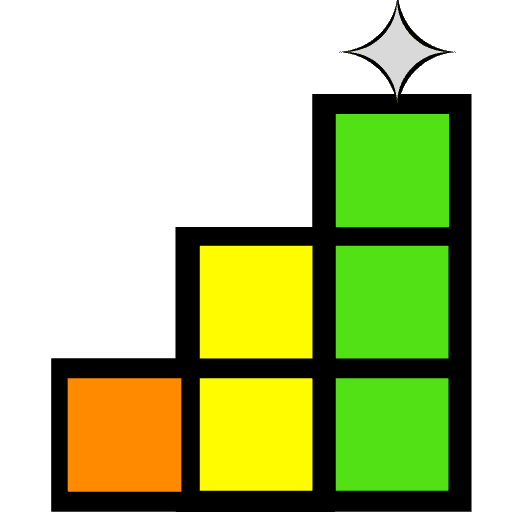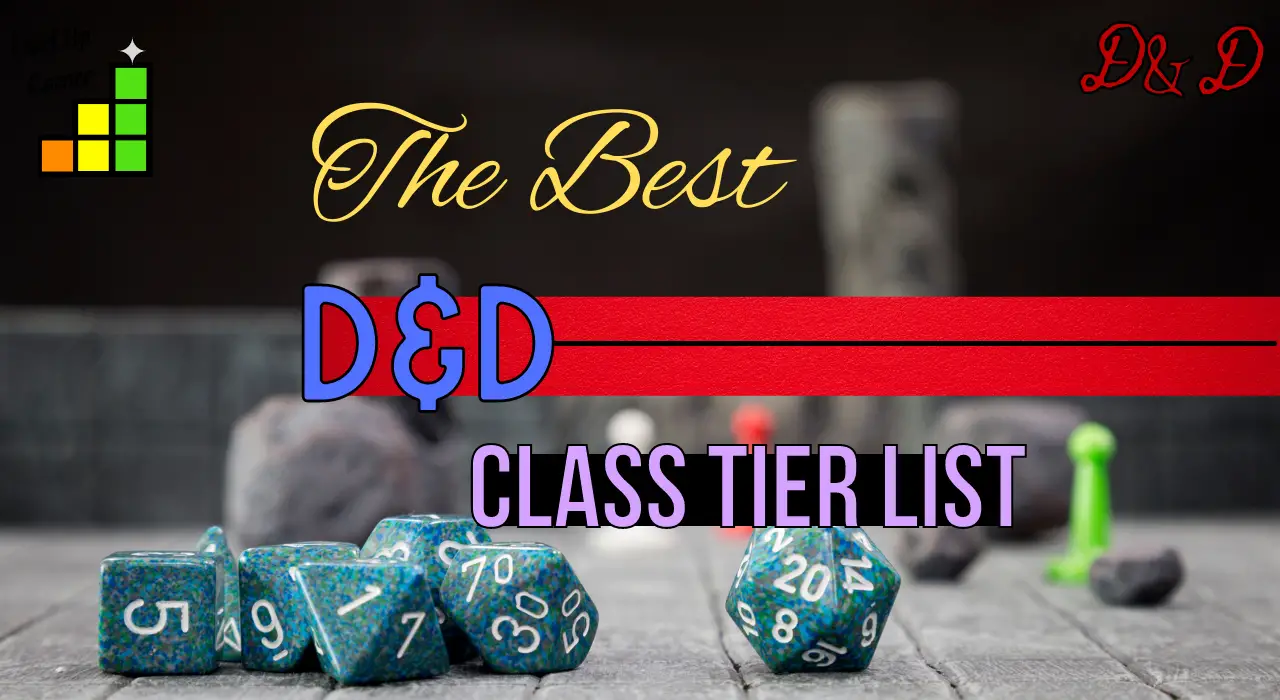In this article, you will find the best D&D 5e class tier list out there (in our opinion, of course)! At the very least, this list will give you a pretty good idea of where every class stands in terms of making an impact on the game. Some classes are just better than others, and we will go over why in this article.
Our considerations for the best D&D 5e class tier list include 1) the ability to interact with the world outside of combat, 2) combat ability, and 3) the ability to impact the game. This tier list will focus on these aspects as objectively as possible.
At the end of the day, any 5e D&D class can still be a good pick if it suits your personal preference. Mechanics are not everything, after all. When played by a great player or in the right campaign, any class can be impactful. And most important is the personal enjoyment you get from playing a particular class.
The Best D&D 5e Class Tier List
We are going to delve right into it! Here is our D&D 5e class tier list followed by the community tier list.
Our Tier List

The Community Tier List

As you can see, there is a GIGANTIC disparity between the two. Our list is more balanced than the community’s since we are taking pure mechanics, impact, and roleplaying capabilities into our ratings. The community thinks that every class is great (which is true in a way) but it doesn’t differentiate between classes very well.
We will start with S tier and work down. For each tier, we will go over how each class fairs across the 3 categories of combat, social, and game impact.
Before we move on….
Combat involves the effect this class has in combat scenarios.
Social is the ability to affect the world outside of combat (without requiring immense creativity), including roleplay and skills.
Game impact is the ability to shake up the plot, instantly win encounters, or unexpectedly increase the work that the Dungeon Master (DM) must put in.
S Tier: Best of the Best

Bard
Bard is our first S class in the D&D class tier list. They are amazing at almost everything, and excellent even when they fall short of amazing. This class has it all, and is always a solid choice.
Combat: This is where bards are the weakest. They would only be A rank if we based our rankings solely on combat. Bards are great support and can do almost anything, but they lack the damage or utility that other classes have. They will never deal damage like a sorcerer or fighter, or have the utility of a wizard. Everything they do is good here, just less than the very best.
Social: Bards live for the social aspect of the game. They are easily S+ rank in this department. A bard’s spell list is geared towards social encounters. Being charisma-based is already good, but having jack-of-all-trades just puts them over the top. Not to mention Bardic Inspiration is an excellent way to help allies!
Game Impact: Bard’s are meant to throw off the DM constantly. This makes them a solid S rank in this category. Their spell list is geared toward changing situations and making their choices have a higher chance of success than should be possible. When a bard casts a spell it is almost never to just deal damage. Their focus is to change the board. In or out of combat, when a bard acts it can almost always change the scenario at hand, or even the campaign.
Cleric
Cleric is our next S class. Many have joked that you could make an entire party of clerics. This is more true than for any other class. Do you need a tank, healer, dps and more? The cleric has it all.
Combat: Clerics are easily S+ rank when it comes to combat. Do you need heals? Clerics have the best heals in the game. What about damage? Clerics at level 1 can deal 4d6 and grant advantage to the next attack. This type of damage is not an anomaly. Utility is easily covered with the cleric’s spell list, and they are all either extremely tanky or an impenetrable wall.
Social: Clerics are an interesting bunch socially. They have to be active in some fashion to embody their beliefs. This causes them to act socially, but they do lack charisma or out-of-combat spells. This is why strangely, I would rank clerics at B rank for social encounters. Mechanically they don’t have a lot going for them here, but spells can help enhance their own social abilities or their allies’.
Game Impact: Clerics have a built-in wish at level 10, and are something that DM has to constantly plan around. The healing, spells, and sheer armor that these beings wear makes them a force to contend with. Clerics are able to change the direction of the plot through clutch plays, or dealing with divinities in social encounters. Clerics don’t always impact the game, but when they do it is in a strong way. This is why they have an S rank in game impact.
Wizard
Wizards are a solid class that can impact the game with instant win buttons, and stops combat in its tracks. They are not as strong socially, but if wizards were as good as bards in the social department then everyone would play a wizard!
Combat: The wizard’s strength is not in damage when it comes to combat. Even if they focus on damaging spells, they won’t do better damage than a sorcerer or other martial classes. Instead, they focus on utility spells, making the combat easier for their allies, or bypassing it altogether. When used well here, wizards are easily S+ rank, but for the average player, they are A rank. The disparity in creative spellcasting is most pronounced in the wizard since they have nothing else to fall back on.
Social: Wizards are not as great socially. What would you expect of a nerd that stays inside most of the time? They have some spells that can be a novelty in social encounters, but their true strength is in information. When using knowledge skills and spells to gather information, Wizards are as high as A rank in the social impact. Knowing your opponent, gaining more options, and preparing before a confrontation easily gives them this rank.
Game Impact: Other classes deal damage in combat, while a good wizard should just end it as quickly as possible. Spells that are prone to do this include polymorph, wall of force, sleep, web, hold person, banish, and so on. The same applies to social encounters or information gathering. Wizards can have the greatest game impact when using their spells well, or they are just mediocre. This is why wizards can have an S+ rank in game impact, but could also be as low as B rank if they aren’t creative.
Wizards require more work from the player than almost any other class to reach their potential, but when played well, they are phenomenal.
Paladin
Our last S tier class is the paladin. They are beyond amazing. Mechanically they are the best S tier class on this list, and here are the reasons why.
Combat: Do you want heals, high AC, high burst damage, spell versatility, and amazing saves? Then look no further. This class is S+ rank here without question. In comparison, fighters only are able to get high AC, while paladins are able to have high AC and high saves. Fighters can deal a little bit more damage over 20 rounds, but most parties rest before then. Lastly, you also have heals and utility.
Social: As a charisma-based class, paladins can have a great impact on social encounters. This is, however, all they have. Since they have nothing else to really impact social encounters other than their raw stats and maybe a proficiency, they get an A rank here. They can’t stealth, don’t know much, and aren’t able to contribute much when they aren’t the one talking. This keeps them from an S rank, but being the talker of the group goes a long way.
Game Impact: Above all else, this class has the most game impact by just being there. Wizards, bards, and clerics can greatly impact the game through their actions. Paladins impact the game by just existing. Every encounter has to be re-thought-out, planned and changed because a paladin is in the party. Because of their innate power, resistances, and damage, they are S rank here. DMs: don’t plan an encounter as normal with a paladin in the group. If you do, it is an easy win for the party.
A Tier: A Good Option

Druid
The druid is our first A class in the D&D class tier list. They are great in many areas but do fall short in some departments. This is an extremely fun class that is able to do a lot with what they are given and is very adaptable.
Combat: No matter how you play them, druids are very dependent upon what opponents they face. Entangle is great, unless you are against a flying opponent. Heat metal is great unless you are facing unarmored opponents. Moonbeam is great if you are facing shapeshifters, and so on. Druids are good in combat, but they are not completely reliable. This is why they are B rank in combat. They can do a lot and have a lot of options, but they are very dependent upon their foes with few solid fallback spells.
Social: At first glance, druids don’t have much going for them socially. They are not charisma based and don’t have the bard’s spell list. There are two pros here, however: animal interactions, and wild shape. Asking a bird about the surrounding land is great. Surveying that land as a bird yourself is wonderful. Sneaking into the room as a rat to overhear a conversation is classic, and wild shape almost solely gives the druid an A rank in social.
Game Impact: Druids have an interesting spell list. They can be absurdly effective or fall short. Druids can and often do make use of wild shape in creative ways. Even something simple like slipping into a locked room as a mouse gives them a decent amount of impact. Druids can change the game in strange ways, but aren’t as grand as wizard, bard, or cleric. This is why they have an A rank in game impact.
Fighter
Fighters are meant to fight! Sure they can do other things, but but what do you think a class named ‘fighter’ is best at?
Combat: Combat is what the fighter is best at! Consistent damage, high AC, and the ability to burst your damage with action surge, makes them easily S+ rank. When you think of the fighter, you don’t think much of them generally. Flashy fireballs always stick out in one’s mind, but when you compare the damage numbers, fighters almost always have the highest damage while also deflecting or absorbing a lot of hits.
Social: A fighter is meant to fight! So when they aren’t fighting, what do they do? Well, this is where the fighter falls short. Most fighters have one or two unique things that they do outside of combat and focus on that almost exclusively. This is why fighters have a C rank in the social category.
Game Impact: Fighters are a lot like paladins. Their sheer existence changes the game. They can take a lot of hits, have high AC, and deal a lot of damage. They don’t have great saves that apply to them and anyone within 10 feet, but their very presence still has an impact. Beyond this though, there isn’t much. With nothing else going for them, fighters only have a B+ rank in the ability to impact the game.
Sorcerer
Sorcerers are glass cannons that can dish out the damage, and that is it! Yes, they have the capability to do more, but they never do. In fact, to do so is almost always the wrong call. Why is this the case?
Combat: Sorcerers blow things up. Can they do more? Yes, they can hold monsters and have a rare utility spell. Sorcerers only know a handful of spells, and this is why they don’t take a lot of utility. A scorching ray is almost always good, but a web spell has conditions. What if you are fighting in an open area? Now you have a quarter of your spells that do nothing. This is why sorcerers just deal a ton of damage and are A rank in combat.
Social: Sorcerers are like paladins. They are charisma based, but have nothing else to back it up. If you wish to see our opinions on this situation, look at paladin’s social ranking. Likewise, we give sorcerer an A rank.
Game Impact: Sorcerers deal damage or maybe throw in a hold person every so often. It is very easy for the DM to know what a sorcerer is capable of since it is all spelled out what they can do. Metamagics? These are what I have. Spells? These are what I have. Due to this, the sorcerer never really gives the DM pause. This is why they get a C rank in game impact.
Rogue
Our last A class in the D&D class tier list is the rogue. This is possibly the highest A tier class. They can excel at almost anything and are a solid choice.
Combat: With their sneak attack, rogues almost always deal a lot of damage. This alone makes them B rank, but with cunning action and their subclasses almost all affecting combat, this boosts them to a solid A rank. If you want to make your rogue S rank, then work with your team. Find ways to use sneak attack as a reaction. If you can do so, then you get sneak attack twice per round which is ridiculously good. Even if you don’t do this, uncanny dodge makes rogues surprisingly tanky.
Social: Rogues are skill monkies. They have so many skills and can expertise up to 4 of them. Even if they don’t take charisma based skills, they can impact the game outside of combat in some way. Stealthing and pickpocketing, are all common ways that rogues impact the game. Due to all their options and how expertise works, rogues get an A rank in social.
Game Impact: Rogues can throw a wrench into the game here and there, but it is rare. Their skill set allows them to be soild in whatever they do, but once again it is up to the player to utilize what they have. This is why rogues can either have a C rank impact on the game, or go all the way up to an A rank.
B Tier: Very Dependent on the Player and Campaign

Artificer
Artificer is our first B class in the D&D class tier list. The artificer is interesting. It does many things and has a wide skillset. The problem is the quality that the artificer is able to put forth.
Combat: Aside from making +1 weapons for your allies, the artificer isn’t able to do much in combat. They don’t have the damage of a fighter or a rogue, and have some utility. The utility is nothing like higher tiers, but it is there. A well optimized or creative artificer could be A rank, but without any help they are around C rank in combat. Artificers are very dependent upon the player and which subclass was taken.
Social: Artificers are meant to make things. They might not be social, but they know stuff and can make things! They don’t have the spells that wizards have, but their impact is almost the same. With this, the artificer gains an A rank in social since they can always have a word or at least do something.
Game Impact: Artificers have a hard time changing the game. Theoretically, they can with their item creation, but it is extremely hard to do so. This is also the only way they can truly impact the game. This is why artificers get a C rank in impacting the game, but can go all the way up to A rank if the player is creative enough.
Warlock
Next up is the warlock. This class has a ton of flavor and can be extremely fun! There is the joke of selling your soul for a cantrip, but if it works it works.
Combat: Warlocks have the most solid cantrip in the game, and have very good spells. Yes, they only have 2 spells per short rest for most of the game, but these spells are equal or at times more powerful than even wizard spells. If you only have 1 long encounter or don’t short rest, warlocks power drastically decreases. This is why the warlock rank is very dependent upon the DM and game you are playing. They range from C rank to A rank dependent upon this.
Social: Warlocks are charisma-based and can have a lot of fun with their patron. There is almost always something to do with a warlock and you are never left wanting. Warlocks can also use their invocations to add an extra layer of interaction that no one thought of. This is why warlocks are A rank when out of combat.
Game Impact: Rarely does a warlock ever change the course of the game. Generally, this is the DM using the warlock’s patron to change things up rather than the warlock doing so. Warlocks rarely make the DM think through their actions, existence, or spell kit. Warlocks are sadly a D rank when impacting the game overall.
Monk
Possibly the coolest B class in the D&D class tier list is the monk. Everyone wants to play monks because they are cool. This is an indisputable fact. The only problem is that they aren’t able to do as much as you think, or want them to do.
Combat: Monks can be amazing in combat. They almost always have one more attack per round than most others. At levels 1-4 they get two attacks. At levels 5+ they get three attacks without using any ki. The problem is strangely enough the monk’s ki. They can be mobile, a great off tank, or get another attack. A monk, however, has to choose which action they take, and then can only do so while they have ki. Monks are like warlocks, dependent upon short encounters with short rests. Monks can range from C rank to A rank dependent upon your DM and how your game is played.
Social: Monks are cool and exist. That is about all they do outside of combat. They are not charisma-based, and almost always are able to stealth. There isn’t any insight from most skills they bring to the table aside from being perceptive or insightful. This leaves the monk with a D rank.
Game Impact: Monks are able to impact the game through their ki. If they choose to off-tank when you didn’t expect it, that can change an encounter. If they stun a target, that changes the encounter. Monks can have an impact on the game but it is not dependent upon DM rolls and many other factors. This is why the monk has a B rank in changing the game.
Ranger
Our last B class in the D&D class tier list is the ranger. This jack-of-all-trades, master-of-none got a buff in Tasha’s Cauldron of Everything that makes them playable. But how good are they?
Combat: With the extra attack, favored foe, hunter’s mark, and decent subclasses, rangers have a solid A rank in combat. They can deal a decent amount of damage, have high health, and are wonderful to have on the team.
Social: Rangers can sometimes track, but this is able to be done by a monk, cleric, or even bard fairly well. Animal interactions are better done with druids, and they just don’t have a lot going for them here. Sadly, this puts rangers at a C rank for their social interactions.
Game Impact: While I try to keep personal opinions out of this, never once have I seen a ranger impact the game in a way that made me think as a DM. The reason for this is that there is nothing in their kit that allows them to do so. They have no surprise abilities that change the course of combat or destroy carefully laid plans by the DM. They have nothing going for them in this department, and while a creative player might be able to pull something off, class-wise they have a D rank. To change the game, you would need to try far more with this class than almost any other.
C Tier: Ok in Some Circumstances

Barbarian
Barbarian is the only C class in our D&D class tier list. This is a very good class, but there are many stipulations to make them work.
Combat: If the barbarian was in a 5 ft high, 30 ft long box they would be an easy S+ rank. Rage is amazing, they have a high health pool, and they are able to get decent AC. Barbarians also deal decent damage, but there is a problem. Your combat capability is very reliant upon your DM. If monsters fly, have mobility spells/abilities, utilize terrain, or use mind control spells, you are worthless. Luckily this isn’t the case very often, but it happens enough to be a concern. Most of the time, barbarians are an A rank in combat.
Social: While barbarians should have the same social score as fighters, fighters are almost always more varied than barbarians. Fighters can be dexterity or strength based while barbarians are always strength based. This puts them in more of a restricted box than fighters and puts them at D rank.
Game Impact: Barbarians impact the game through their existence alone, much like paladins. They are tanky, deal strong damage, and are very powerful in the right situation. Unlike a paladin, it is laughably easy to make a barbarian worthless. This is why most of the impact comes from the campaign choices the DM makes. I give Barbarians a D rank here for this reason.
Conclusion
I hope that you enjoyed our D&D class tier list. This was based mostly on the mechanical aspects of D&D 5e, but some classes do vary a lot by DM, player, and campaign. We hope that you gained some insight on what class to play next!
Just remember that every class is playable. They can all be fun. Some just need a bit more work than others.
This has been Wizo, and keep rolling!
Find us on Twitch:
https://www.twitch.tv/levelupcorner
Find us on YouTube:
https://www.youtube.com/channel/UCWNkoo0iRoysNdlkWZdfnrQ
Want to support our creators? Find our Patreon here:




